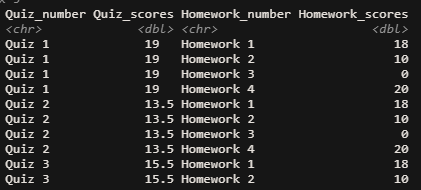Hi all,
I'm trying to abandon my mass of Excel spreadsheets for grading my college class, but I'm running into a few snags. First off is trying to figure out how to drop the lowest quiz grade. A snippet of de-identified data is below:
gradebook=tibble::tribble(
~name, ~Quiz_number, ~Quiz_score, ~Homework_number, ~Homework_score,
"Person A", 1L, 19, 1L, 18L,
"Person A", 2L, 13.5, 2L, 10L,
"Person A", 3L, 15.5, 3L, 0L,
"Person A", 4L, 10.5, 4L, NA,
"Person A", 5L, NA, 5L, NA,
"Person B", 1L, 24, 1L, 19L,
"Person B", 2L, 19, 2L, 20L,
"Person B", 3L, 25, 3L, 20L,
"Person B", 4L, 18.75, 4L, NA,
"Person B", 5L, NA, 5L, NA,
"Person C", 1L, 18, 1L, 18L,
"Person C", 2L, 22, 2L, 18L,
"Person C", 3L, 22, 3L, 18L,
"Person C", 4L, 22, 4L, NA,
"Person C", 5L, NA, 5L, NA,
"Person D", 1L, 14, 1L, 18L,
"Person D", 2L, 18, 2L, 17L,
"Person D", 3L, 16.5, 3L, 16L,
"Person D", 4L, 14.5, 4L, NA,
"Person D", 5L, NA, 5L, NA
)
NA means I'm still waiting on a submission; 0 means the deadline has past and they missed it.
The line gradebook%>%group_by(name)%>%slice_min(Quiz_score) kind of works in that it selects each person's lowest quiz grade, but it does the opposite of what I want in that it keeps that grade and discards the rest. I need a code that groups by name and then removes the row with the lowest value.

